Data Science Course Notes
Enhance your learning journey with in-depth data science lecture notes. Deepen your understanding of core concepts in data science, statistics, probability, Python, and machine learning.Course notes are the perfect complementary online data science study materials. They help you grasp fundamental concepts, refresh your memory when preparing for exams, and get a taste of our learning style.
Committed to your career success and development, we at 365 Data Science support you throughout your learning journey with free resources designed to enhance and guide your education. Our rich selection covers everything from data science notes for beginners to simplified explanations of advanced topics. Choose a subject you wish to master, download our free PDF course notes, and start learning.

Intro to AI Course Notes
Our Intro to AI Course Notes provides a thorough overview of artificial intelligence fundamentals to help you master foundational concepts and get started with advanced techniques. These notes are an essential part of our Intro to AI course and cover a wide range of topics—from machine learning basics to deep learning and AI techniques—offering a solid foundation for anyone interested in AI. Key topics discussed: AI Fundamentals: Natural vs Artificial Intelligence, history, and critical concepts Data in AI: The role of structured and unstructured data and data collection methods AI Techniques: Machine learning (supervised, unsupervised, reinforcement) and deep learning AI Branches: Robotics, computer vision, and generative AI Generative AI and NLP: Development of language models and advancements in NLP These AI lecture notes are a valuable resource for students and professionals that will help you understand the intricacies of artificial intelligence and prepare you for various AI job roles. If you wish to explore AI and understand what it takes to succeed in this rapidly evolving field, download our Intro to AI Course Notes for a comprehensive guide.
Learn More
SQL DELETE Statement Notes
Our SQL DELETE Statement notes provide a comprehensive guide to the SQL DELETE Statement—essential for removing unwanted data from your databases. What is the SQL DELETE Statement? The SQL DELETE statement is a fundamental SQL command that deletes existing records in a database. These notes explain the syntax needed to write effective DELETE SQL queries. You’ll learn about the DELETE FROM WHERE conditions command, which allows you to specify the exact SQL rows to delete. Understanding how to delete a row in SQL is crucial for maintaining clean and efficient databases. One of the critical aspects covered in these notes is the ON DELETE CASCADE option, which is part of the foreign key constraint. This option ensures that if a specific value from the parent table’s primary key is deleted, all corresponding records in the child table will also be removed. This feature is essential for maintaining referential integrity within your database. The notes also compare the SQL DELETE command with other SQL commands for removing data, such as TRUNCATE and DROP. The section on TRUNCATE vs DELETE highlights the differences in performance and usage scenarios between these two commands. The DROP vs TRUNCATE vs DELETE section also provides insights into when to use each command for optimal database management.
Learn More
SQL UPDATE Statement Notes
Our SQL UPDATE Statement notes offer a comprehensive guide to the SQL UPDATE Statement—essential for modifying existing data in your databases. What is the SQL UPDATE Statement? The SQL UPDATE is a crucial SQL command used to modify existing records in a database. These notes provide detailed information on the syntax needed to write effective SQL UPDATE statements. You learn about the UPDATE table_name SET column_1 = value_1 command, which allows you to update specific columns, and the SQL WHERE condition, which ensures you only update the desired records. Additionally, this guide covers SQL best practices for handling database updates to provide accurate and efficient data management. You can execute precise and controlled updates by mastering the SQL UPDATE syntax and understanding the use of TCL commands. The notes explore the TCL COMMIT and TCL ROLLBACK commands—essential for managing transactions in SQL. The COMMIT statement saves the transaction in the database, while the ROLLBACK clause allows you to revert to the last committed state, ensuring your data remains consistent and accurate.
Learn More
SQL Insert Statement Notes
Our SQL INSERT Statement Notes offer a comprehensive guide to the SQL INSERT Statement—essential for adding new data to your databases. What is the SQL INSERT Statement? The SQL INSERT statement is a vital SQL command to add new records to a database. This resource provides detailed information on the syntax needed to write effective INSERT statements. You can learn how to update your database and add new information, including the INSERT INTO statement—allowing you to add data to specific columns—and the INSERT INTO SELECT command, which facilitates inserting data from one table into another. Download these SQL INSERT Statement notes to thoroughly understand one of SQL's most essential commands. With this resource, you'll confidently manage and add data to databases—ensuring your data management practices are efficient and effective.
Learn More
SQL SELECT Statement Notes
Our SQL Select Statement notes offer an in-depth exploration of the SQL SELECT statement—essential for effectively querying and retrieving data from databases. What is the SQL Select Statement? The SQL SELECT statement is fundamental in SQL—allowing you to extract specific data from a database. This resource covers the core syntax required to write effective SELECT statements, including using SELECT FROM and the WHERE clause to filter data. You learn about the AND operator and OR operator for combining multiple conditions and understand operator precedence to ensure your queries return the correct results. Additionally, this resource explains how to use wildcard characters to search for patterns within your data and the BETWEEN AND clause for selecting values within a specific range. The IS NULL and IS NOT NULL conditions help you handle missing data, while various comparison operators allow precise data filtering.
Learn More
SQL Syntax & Theory Notes
SQL (Structured Query Language) encompasses a wide array of SQL commands that allow for comprehensive management and manipulation of databases. This resource explores the intricacies of SQL syntax and SQL commands, detailing: Data Definition Language (DDL) Data Manipulation Language (DML) Data Control Language (DCL) Transaction Control Language (TCL) It offers comprehensive insights into interacting with database objects. Key topics cover SQL syntax fundamentals—including basic structure and rules for crafting queries, essential SQL keywords for mastering SQL operations—and various statement types like CREATE, ALTER, DROP, RENAME, and TRUNCATE. By mastering these SQL commands and SQL keywords, you'll be well-prepared to handle any database-related task efficiently.
Learn More
SQL Notes: Basics
Our SQL Basics Resource offers a comprehensive overview of essential SQL concepts and commands—crucial for anyone looking to master database management and manipulation. Download our free SQL PDF and get started with SQL notes to help you understand the core of this essential query language. What is SQL? SQL (Structured Query Language) is the standard language for managing and manipulating databases. These SQL notes explore the language’s core elements, such as SQL Query Structure and essential commands for effective database interaction. They introduce: Data Definition Language (DDL) Data Manipulation Language (DML) Data Control Language (DCL) Transaction Control Language (TCL). This guide covers SQL Syntax—essential structures and rules for crafting queries. Learn to: Retrieve data with the SQL SELECT statement. Modify data using the SQL UPDATE statement. Add new entries with the SQL INSERT statement. Remove data via the SQL DELETE statement. You’ll also find information on SQL keywords, helping you familiarize yourself with essential terms and their uses. Additional topics include GROUP BY and HAVING—exploring grouping data and filtering group results—and the WHERE clause, which explains how to specify conditions for data retrieval. Explore SQL operators and SQL wildcards to refine queries, including SQL BETWEEN and SQL comparison operators for range-based selection and comparisons. This resource also explains SQL DISTINCT for filtering unique values and the distinctions between SQL TRUNCATE and SQL DELETE, which detail methods for removing data and deleting tables. The SQL PDF covers SQL GRANT and REVOKE for user permissions and database security, along with SQL database administration techniques for effectively managing and maintaining your databases.
Learn More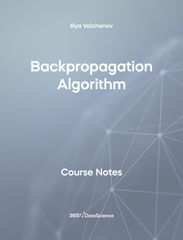
Backpropagation Algorithm
The backpropagation algorithm is the fundamental building block of neural networks and is used to effectively train them through the chain rule method- a technique used to find the derivatives of cost, considering any variable in a nested equation. While most packages already contain backpropagation algorithms in them, knowing the math behind them and how they work will help you better understand more advanced algorithms as well as handle vanilla ones with ease. Check out these free short pdf course notes on the backpropagation algorithm to learn some of the useful formulas and finding the results for backpropagation for the output layer and hidden layer.
Learn More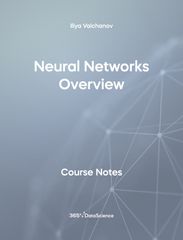
Neural Networks Overview
Currently, the closest technology to mimicking the human brain and learning process is deep learning. It uses mathematical functions to map the input to the output and form patterns out of the data. Computationally superior to machine learning, deep learning can even analyze huge sets of unstructured data. At the heart of deep learning are neural networks which mimic the neuron activity in the human brain, enabling us to learn the structure of data by performing various tasks, without the need for human intervention. Check out these short free pdf course notes to find out the three layers of deep neural networks and the activation functions.
Learn More
Intro to Neural Networks
Machine Learning is the field concerned with building computational models that can execute high-level tasks using human-like reasoning. In other words, machine learning models possess the ability to learn autonomously. The recent introduction of neural networks has opened a new set of possibilities for machine learning and deep learning. Before you explore them, check out these free pdf course notes on intro to neural networks and get to know the building blocks of a machine learning algorithm, and the two types of supervised learning- regression and classification.
Learn More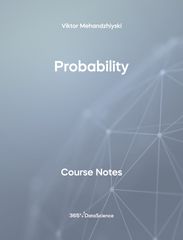
Probability
We use the intuitive concept of probability on a daily basis in our lives, just by the mere fact that we live in constant uncertainty. Data Science is one of the fields where we need to have conscious mastery and understanding of probability – the backbone of many important data science concepts. If you want to adopt the probabilistic mindset then check out our free pdf course notes which will teach you the basics of probability, combinatorics, Bayesian Notation, discrete distributions, continuous distributions, setting up and solving integrals and expressing complex formulas in Wolfram Alpha.
Learn More
Python for Finance
Python is a high-level multipurpose programming language that is popular among all levels of programmers/data practitioners working in the field of education, big tech, transportation, science, agriculture and last but not least- finance. The plethora of Python libraries, its intuitive syntax, and wide range of tools allow Python to provide data-driven solutions to financial institutions of all sizes. In these free pdf course notes, we will explore the power of Python for finance, covering tools and techniques used by financial professionals such as calculating and comparing rates of return in Python, measuring investment risk, performing regression analyses, using Monte Carlo simulations as decision-making tools and much more.
Learn More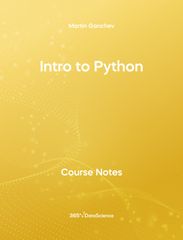
Intro to Python
Python is the top programming language in both the TIOBE and PYPL Index, making it one of the most popular programming languages worldwide. This is all thanks to its intuitive, beginner-friendly syntax and wide range of real-world applications like web development, scientific computing, game development, AI & machine learning, graphic design etc. But before you can dwell in this vast world of possibilities, you need to learn the basics of Python. We introduce you the free pdf Intro to Python course notes where you will learn basic Python syntax, how to create and use functions, conditional statements , iteration and much more.
Learn More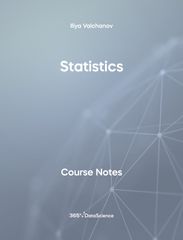
Statistics
Before we can build machine learning algorithms or extract valuable insight from our data we need to transform the raw data into an understandable format and check its quality. In other words, we need to do data preprocessing, which requires statistical knowledge every step along the way. Therefore, learning statistics is a must-have skill when doing data science. In these free pdf course notes, we will be covering the fundamentals of statistics, the different types of distributions, confidence intervals and respective formulas, calculation of covariance and correlation, hypotheses testing, and much more
Learn More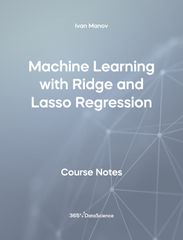
Machine Learning with Ridge and Lasso Regression
One of the most common problems every data scientist faces when training machine learning models is overfitting—overcomplicating the model with irrelevant data, thereby reducing the model’s predictive and classification capabilities. This is where the regularization techniques -ridge and lasso come to the rescue, as they simplify the model and remove all the data noise. In these free pdf course notes, we will cover the basic concepts behind regression analyses, ridge vs lasso regression, cross validation for choosing a tuning parameter and relevant metrics for evaluating the model’s performance.
Learn More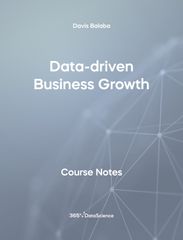
Data-Driven Business Growth
Becoming a data-driven organization requires much more than investments in data science and machine learning. A company can have as many data professionals and data resources available and still fail in leveraging them to reach organizational objectives. This is where data maturity comes into play, as it provides a framework for companies-small and big to build the necessary data-driven infrastructure. In these Data-driven Business Growth course notes we are going to cover the importance of the growth mindset , cover the 3 stages of data maturity, how to pass each stage.
Learn More
Starting a Career in Data Science
The data science career path has become increasingly competitive over the years, as the supply of data scientists is slowly outpacing the demand. Landing a data scientist job now is harder than 5 years ago, and employers have become more selective in the recruiting process. Businesses are looking for competent data scientists with solid preparation. Therefore, in these free pdf course notes you will be taught how to create a professional data science project portfolio, build a job-landing resume, ace the data science interview questions, solve the take-home test and ultimately start a career in data science.
Learn More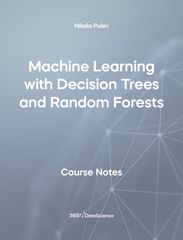
Machine Learning with Decision Trees and Random Forests
Decision trees are a popular intuitive supervised machine learning algorithm, that is part of the sklearn library, and has wide areas of applications like- business growth opportunities evaluation, demographic-driven data client targeting, and strategic management planning. Every machine learner worth their salt needs to familiarize themselves with the decision trees machine learning model. These free machine learning with random forests and decision trees pdf course notes will teach you how do decision trees work, how they ensemble into the random forest algorithm, what are their pros and cons, which are the most commonly used performance metrics and much more.
Learn More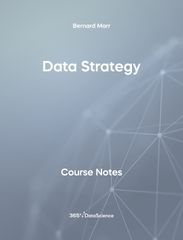
Data Strategy
Companies that sit on treasure troves of data but have no defined or bad data strategy not only fail to collect dividends from their wealth of data, but also incur great financial and reputational losses. In these free pdf course notes on Data Strategy, you will learn what is the purpose of a company’s data strategy, how data strategy helps build competitive advantage, how to create technology and data infrastructures that support business growth and much more.
Learn More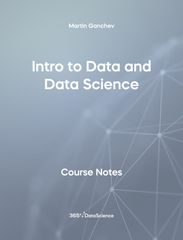
Intro to Data and Data Science
Rapid technological advancements and the invention of the world wide web have revolutionized the way we view and interact with data, turning data science into an integral part of the business landscape- 50% of the top companies implement data-driven practices. Therefore, if you want to make your first professional steps and find your bearings in the complex world of data science, we recommend you to download these free pdf course notes to Intro to Data and Data Science.
Learn More